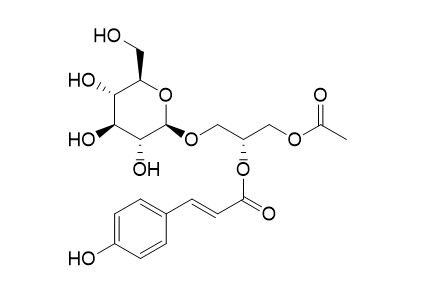Regaloside I
Regaloside I, which has the structure of phenylpropanolglycerol glycoside, acts as an active compound that inhibits the upregulation of CAPZA1 and inhibits UVA-induced changes in HDF shape, which in turn inhibits collagen reduction.
Inquire / Order:
manager@chemfaces.com
Technical Inquiries:
service@chemfaces.com
Tel:
+86-27-84237783
Fax:
+86-27-84254680
Address:
1 Building, No. 83, CheCheng Rd., Wuhan Economic and Technological Development Zone, Wuhan, Hubei 430056, PRC
Providing storage is as stated on the product vial and the vial is kept tightly sealed, the product can be stored for up to
24 months(2-8C).
Wherever possible, you should prepare and use solutions on the same day. However, if you need to make up stock solutions in advance, we recommend that you store the solution as aliquots in tightly sealed vials at -20C. Generally, these will be useable for up to two weeks. Before use, and prior to opening the vial we recommend that you allow your product to equilibrate to room temperature for at least 1 hour.
Need more advice on solubility, usage and handling? Please email to: service@chemfaces.com
The packaging of the product may have turned upside down during transportation, resulting in the natural compounds adhering to the neck or cap of the vial. take the vial out of its packaging and gently shake to let the compounds fall to the bottom of the vial. for liquid products, centrifuge at 200-500 RPM to gather the liquid at the bottom of the vial. try to avoid loss or contamination during handling.
Plant Physiol.2023, 193(3):1758-1771.
Pharmacognosy Journal2019, 11,6:1235-1241
Nutrients.2022, 14(23):4997.
Nutrients2023, 15(18), 4016.
Life (Basel).2022, 12(12):2107.
J Ethnopharmacol.2019, 236:31-41
Pharm Biol.2017, 55(1):360-366
J Vet Sci.2020, 21(3):e39.
J Pharm Biomed Anal.2024, 251:116444.
Molecules.2020, 25(23):5556.
Related and Featured Products
Exp Dermatol . 2016 Aug;25 Suppl 3:45-51.
Morphological change of skin fibroblasts induced by UV Irradiation is involved in photoaging[Pubmed:
27539902]
Human dermal fibroblasts (HDFs) are typically flattened or extensible shaped and play a critical role in the metabolism of extracellular matrix components. As the properties of fibroblasts in the dermis are considered to be influenced by their morphology, we investigated the morphological changes induced in fibroblasts by ultraviolet (UV) irradiation as well as the relationship between these changes and collagen metabolism. In this study, we showed that UVA exposure induced morphological changes and reduced collagen contents in HDFs. These morphological changes were accompanied a reduction in actin filaments and upregulation of the actin filament polymerization inhibitor, capping protein muscle Z-line ɑ1 (CAPZA1). External actin filament growth inhibitors also affected the shape of HDFs and reduced collagen levels. These results suggest that UVA exposure may inhibit the polymerization of actin filaments and induce morphological changes in skin fibroblasts. These morphological changes in fibroblasts may accelerate reductions in collagen synthesis. This mechanism may be one of the processes responsible for collagen reductions observed in photoaged skin. When natural materials that suppress these morphological changes in HDFs were evaluated, we found that an extract of Lilium 'Casa Blanca' (LCB) suppressed UVA-induced alterations in the shape of HDFs, which are typically followed by inhibition of collagen reduction. An analysis of the active compounds in LCB extract led to the identification of Regaloside I, which had a structure of phenylpropanoid glycerol glucoside, as the active compound inhibiting the upregulation of CAPZA1. Therefore, inhibition of UVA-induced morphological changes in HDFs is considered to be promising way for the suppression of collagen reduction in photoaging.
Exp Dermatol . 2016 Aug;25 Suppl 3:45-51.
Morphological change of skin fibroblasts induced by UV Irradiation is involved in photoaging[Pubmed:
27539902]
Human dermal fibroblasts (HDFs) are typically flattened or extensible shaped and play a critical role in the metabolism of extracellular matrix components. As the properties of fibroblasts in the dermis are considered to be influenced by their morphology, we investigated the morphological changes induced in fibroblasts by ultraviolet (UV) irradiation as well as the relationship between these changes and collagen metabolism. In this study, we showed that UVA exposure induced morphological changes and reduced collagen contents in HDFs. These morphological changes were accompanied a reduction in actin filaments and upregulation of the actin filament polymerization inhibitor, capping protein muscle Z-line ɑ1 (CAPZA1). External actin filament growth inhibitors also affected the shape of HDFs and reduced collagen levels. These results suggest that UVA exposure may inhibit the polymerization of actin filaments and induce morphological changes in skin fibroblasts. These morphological changes in fibroblasts may accelerate reductions in collagen synthesis. This mechanism may be one of the processes responsible for collagen reductions observed in photoaged skin. When natural materials that suppress these morphological changes in HDFs were evaluated, we found that an extract of Lilium 'Casa Blanca' (LCB) suppressed UVA-induced alterations in the shape of HDFs, which are typically followed by inhibition of collagen reduction. An analysis of the active compounds in LCB extract led to the identification of Regaloside I, which had a structure of phenylpropanoid glycerol glucoside, as the active compound inhibiting the upregulation of CAPZA1. Therefore, inhibition of UVA-induced morphological changes in HDFs is considered to be promising way for the suppression of collagen reduction in photoaging.



